Parrotfish
scaridae
The parrotfish can change from female to male at some point in its life.
Advertisement
Parrotfish Scientific Classification
- Kingdom
- Animalia
- Phylum
- Chordata
- Class
- Actinopterygii
- Order
- Labriformes
- Family
- Scaridae
- Scientific Name
- scaridae
Read our Complete Guide to Classification of Animals.
Parrotfish Conservation Status
Parrotfish Facts
- Prey
- Algae, invertebrates, and detritus
- Group Behavior
- School
- Fun Fact
- The parrotfish can change from female to male at some point in its life.
- Estimated Population Size
- unknown
- Biggest Threat
- Climate change and pollution
- Most Distinctive Feature
- The parrot-shaped beak
- Other Name(s)
- none
- Gestation Period
- a few days
- Optimum pH Level
- unknown
- Habitat
- Coral reefs, seagrass beds, and coasts
- Predators
- Sharks and eels
- Diet
- Herbivore
- Type
- ray-finned fish
- Common Name
- parrotfish
View all of the Parrotfish images!
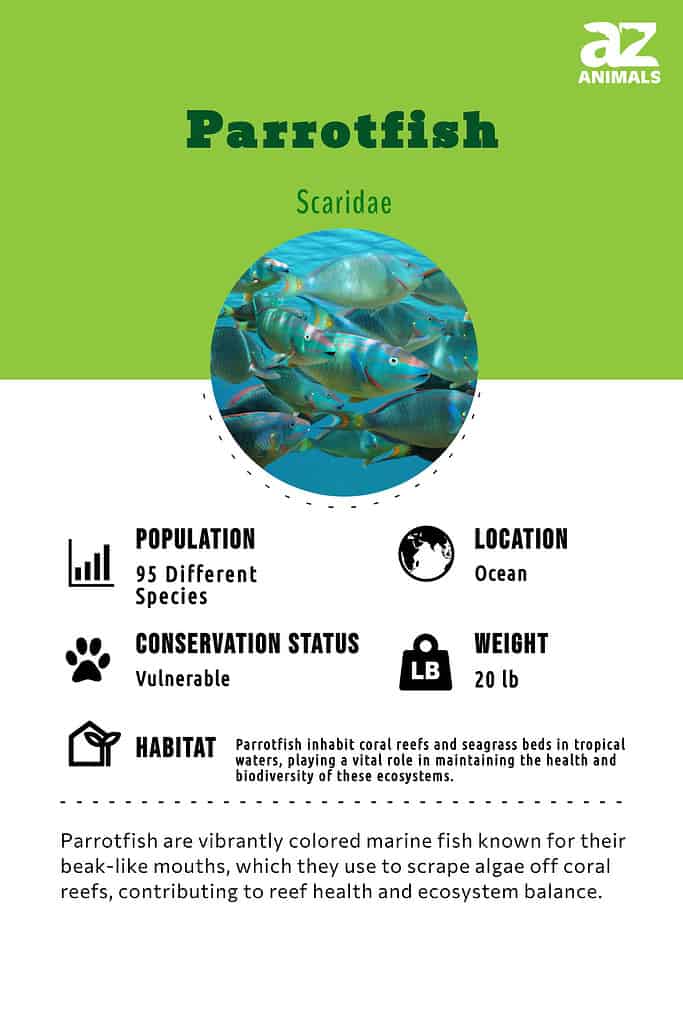
The parrotfish has the ability to switch between sexes at certain points of its life.
The parrotfish is a family of about 80 to 90 species. They are named for their unusual parrot-like beak and bright colors along the body.
There are very few animals quite like them in the entire ocean. Some of the best-known species include the princess, green humphead, and queen parrotfish.
Despite their beautiful blue, red, and green colors, they are not normally kept as aquarium fish due to their unique feeding behavior.
5 Parrotfish Facts
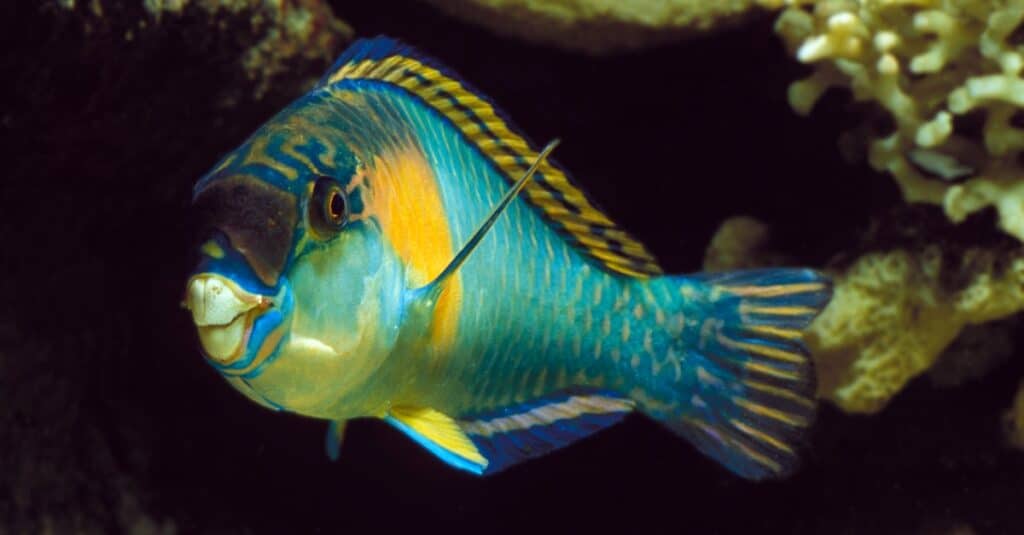
By propelling itself through the water using either its pectoral or side fins, it possesses the capability to swim.
©slowmotiongli/Shutterstock.com
- Most parrotfish start as female and only become male later on, but it depends on the species. The transformation from female to male is regulated by hormones within the body.
- It has the ability to swim by rowing its pectoral or side fins through the water.
- This fish performs most of its hunting in the daylight hours. After midnight it hides in the sand or rocky crevices to avoid predators. Some species will secrete a mucous all over its body to provide protection from predators, parasites, and UV light.
- When a parrotfish feeds on algae, it will bite off a piece of coral. These pieces pass through its digestive system and then leave with the poop as white coral sand. Many tons of this sand (which, to be clear, is not the parrotfish poop but rather a byproduct of the coral reef) may be deposited every year and washed up on the beach.
- These are highly social animals found in large schools of 40 individuals. These schools are often led by a territorial “super male” who may chase other males away.
Evolution and Origins
Parrotfish are distributed across global tropical coral reefs and seagrass beds, inhabiting various regions such as the Caribbean, Mediterranean, Pacific, Atlantic, and Indian Oceans.
The bump head parrotfish exhibits a prominent hump on its face, the stoplight parrotfish displays an amber dot resembling a traffic light on its tail, and the scribble face parrotfish showcases vibrant shades of orange, green, and purple.
Parrotfish are known for their abundant eating habits as well as their copious excretions. Furthermore, parrotfish possess the ability to change colors and switch genders fluidly.
The presence of parrotfish is crucial in preventing the rapid overgrowth of seaweeds that could suffocate corals on numerous reefs worldwide, as seen in the Caribbean and Pacific regions.
Different Types
- Blue parrotfish
- Green humphead parrotfish
- Rainbow parrotfish
- Stoplight parrotfish
- Marbled parrotfish
- Sparisoma cretense
- Scarus
- Bicolour parrotfish
- Princess parrotfish
- Knobsnout parrotfish
- Sparisoma
- Calotomus japonicus
- Chlorurus microrhinos
- Calotomus
- Hipposcarus harid
- Calotomus carolinus
- Bleeker’s Parrotfish
- Bower’s Parrotfish
- Indian Parrotfish
- Raggedtooth Parrotfish
- Nicholsina
Classification and Scientific Name
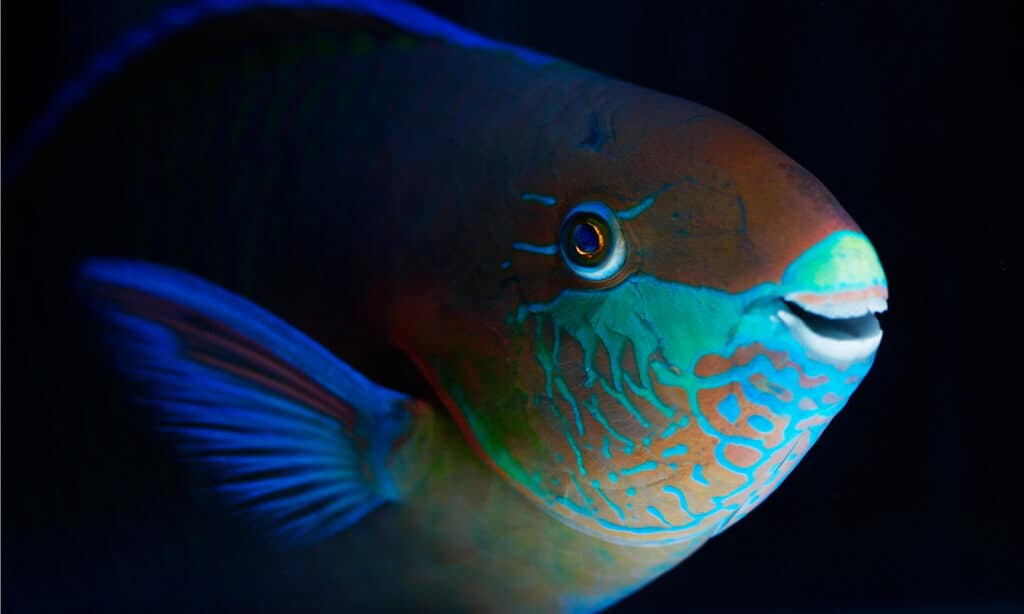
The scientific name Scaridae is derived from the Latin word “scarus,” which refers to a Mediterranean fish food commonly linked with parrotfish.
©Pavaphon Supanantananont/Shutterstock.com
The scientific name is Scaridae. This is derived from the Latin word scarus, a Mediterranean fish food often associated with parrotfish.
The number of species is difficult to identify because their appearance varies by age and sex. More than 350 different color forms have been identified, but there may only be about 80 to 90 species. They are closely related to wrasses and cales within the order Labriformes.
Appearance
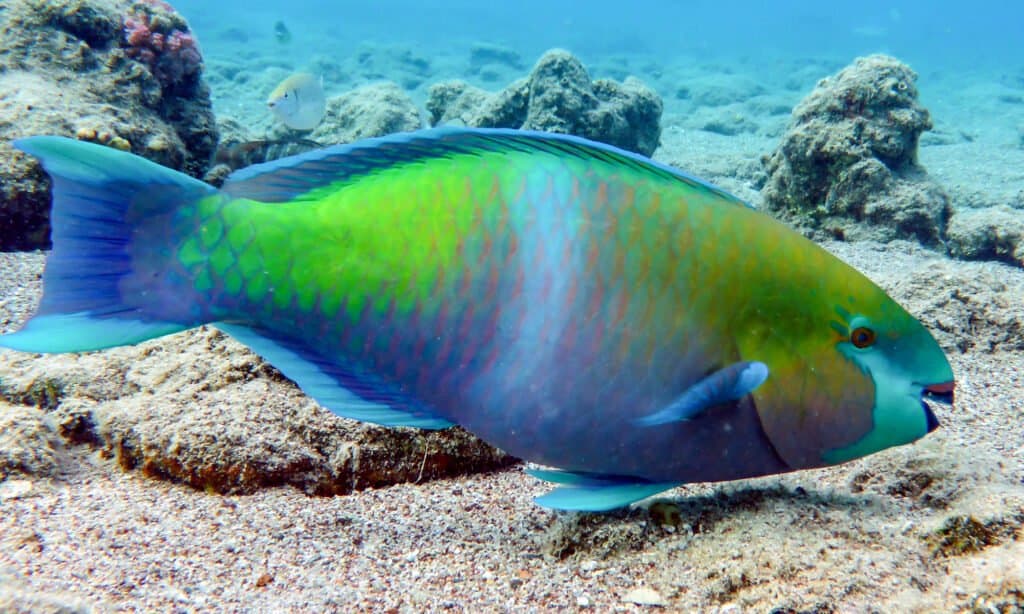
This fish has a tapered body with fused teeth forming a beak-like plate around the mouth, and it also has a secondary set of teeth for grinding food at the back of the throat.
©FromMyEyes/Shutterstock.com
This fish is characterized by a long “fusiform” (meaning tapered) body with fused teeth that form a beak-like plate around the mouth; there is also a second set of teeth near the back of the throat to grind up food.
These fish can come in a wide array of bright colors, including red, green, yellow, and blue, all mixed in with black or brown.
Their large, thick scales are so tough that in some species they can deflect the thrust of a spear. Most species are somewhere in the range between 1 and 4 feet long. The largest species is the green humphead; the humphead can measure up to 4 feet 3 inches long. The smallest is the bluelip at 5 inches long.
There are extraordinary differences between male and female parrotfish, to the point where they are often mistaken for different species. Some can even change their color to temporarily mimic other types of fish.
Distribution, Population, and Habitat
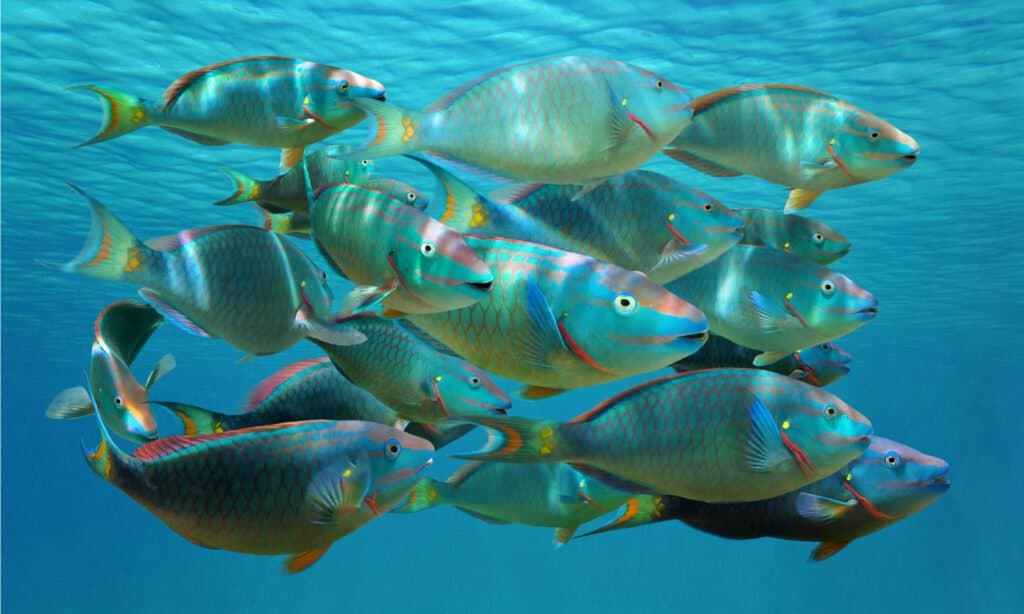
Parrotfish are distributed across global tropical coral reefs and seagrass beds, inhabiting various regions such as the Caribbean, Mediterranean, Pacific, Atlantic, and Indian Oceans.
©Damsea/Shutterstock.com
Parrotfish can be found in tropical coral reefs and seagrass beds all around the world, including the Caribbean, Mediterranean, Pacific, Atlantic, and Indian Oceans.
These coral reefs provide protection and food for the parrotfish. The Caribbean includes well-known species like the princess and queen parrotfish. The Mediterranean contains the appropriately named Mediterranean parrotfish.
According to the IUCN Red List, most parrotfish are considered to be species of least concern (though a few are threatened). Because climate change, pollution, and overfishing damage many coral reef systems, they could be threatened in the future.
Predators and Prey
The parrotfish is an important part of the ecological system in which it’s found. It feeds on small bits of organic matter and likewise provides food for carnivorous predators. Many come out after midnight to hunt.
What eats the parrotfish?
Parrotfish are preyed upon by sharks and eels. Their hard scales and foul-smelling mucous membrane both provide a defense against potential predators. They are also quite adept at hiding from danger in the soil or dark crevices.
What does the parrotfish eat?
The parrotfish uses its beak-like teeth to grasp algae from corals and rocks.
Small polyps growing on the surface of the coral can contain symbiotic algae that attract the parrotfish; by consuming bits of the coral that pass out through their poop, they contribute to the creation of sediments in their natural habitat.
Parrotfish also consume a wide array of smaller invertebrates, plankton, and small organic matter. Both the princess and queen parrotfish feed on sponges in the Caribbean.
Reproduction and Lifespan
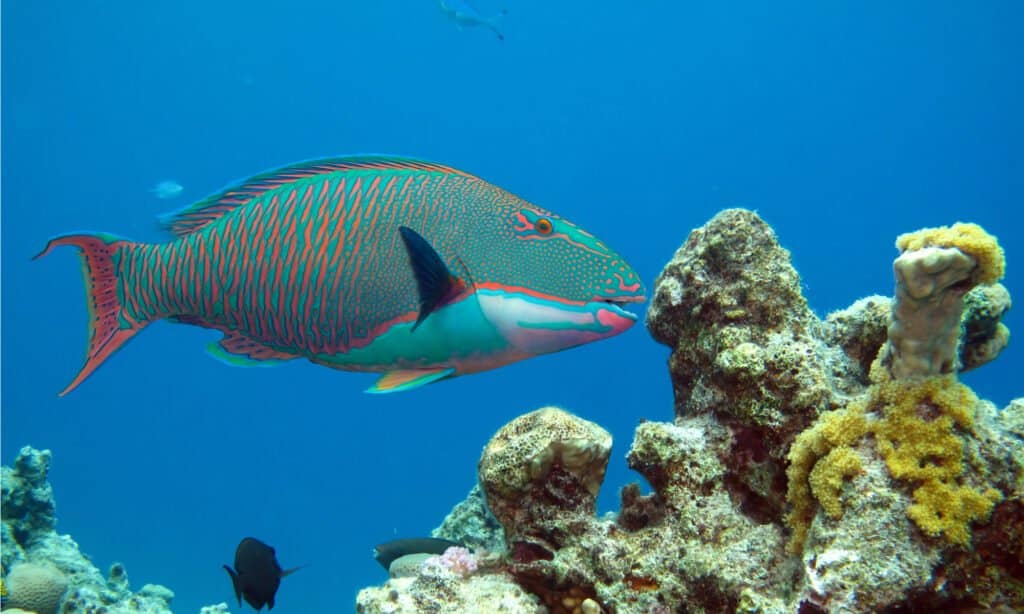
The parrotfish uses its beak-like teeth to grasp algae from corals and rocks.
©Cigdem Cooper/Shutterstock.com
Parrotfish usually form large groups in which a single male has exclusive breeding rights with many females. Some species are also organized into cooperative breeding groups or simple pairs. They have the ability to spawn all year round, especially in the dusk hours before midnight, but summer is usually the peak reproductive period.
The female will release a clutch of eggs into the water, which will then be dispersed by the tide. The eggs will hatch after about a day of fertilization. They will begin to feed around the third day. It takes about two to four years to reach full sexual maturity.
As mentioned previously, the parrotfish has a very complex sex system that varies by species. Males can be either primarily male (meaning they remain males their entire lives) or secondary male (meaning females that transform into males later).
Most species are secondary males, in that they start life as females and transform into males, but some are primary males or have an even mixture of both primary and secondary in their population. Parrotfish can undergo sex switching at various points of their lives as the circumstances demand it.
Only a single species, the marbled parrotfish, is known to remain the same sex for its entire life. The maximum lifespan is around 20 years old, but many don’t live much longer than five to seven years in the wild.
Fishing and Cooking
The parrotfish is rarely eaten in the United States, but it is considered to be a delicacy in the Pacific and Caribbean regions. With its sweet tender taste, the parrotfish is often fried, steamed, or stewed. In many Polynesian societies, raw meat was once reserved exclusively for the king.
View all 192 animals that start with PParrotfish FAQs (Frequently Asked Questions)
Where are parrotfish found?
They are found in tropical waters all over the world around coral reef systems.
What is parrotfish?
A parrotfish is a family of some 80 to 90 species that are most recognized by their parrot-like “beak.”
Why is parrot fish not good?
Parrotfish generally cause no harm to people. However, some species have caused fish poisoning sickness in humans when eaten.
What does parrotfish look like?
The parrotfish looks like a medium-sized, brightly colored fish with a parrot-like beak on its mouth.
Is parrotfish good eating?
The parrotfish is considered to be a delicacy in some tropical parts of the world. It is a good source of many vitamins and minerals, as well as omega-3 fatty acids.
What does a parrotfish get eaten by?
The parrotfish is consumed by some sharks and eels.
What does parrotfish taste like?
It is said to have the taste of sweet tender white meat.
Where do parrotfish live?
They live primarily around coral reefs, rock crevices, and seagrass beds.
What do parrotfish eat?
Their diet mostly consists of algae, but they also consume some small invertebrates, plankton, and other organic matter.
Thank you for reading! Have some feedback for us? Contact the AZ Animals editorial team.


















